Understanding the Eagle Symbol and Meaning in St John’s Iconography
The St John Eagle symbol encapsulates vast theological, historical, and artistic significance. Rooted in early Christian iconography, it projects strength, courage, and spiritual ascension.
Biblically, the eagle represents divine revelation, with Isaiah 40:31 and the Book of Revelation highlighting its grandeur. In art, the eagle's soaring imagery complements St John's profound theological insights.
As part of medieval and Renaissance traditions, it signified vision and prophetic clarity. Evolving through centuries, the symbol's relevance transcends religious contexts, embodying intellectual acumen and visionary leadership.
To fully grasp its multifaceted impact, one can explore its diverse representations and cultural significance further.
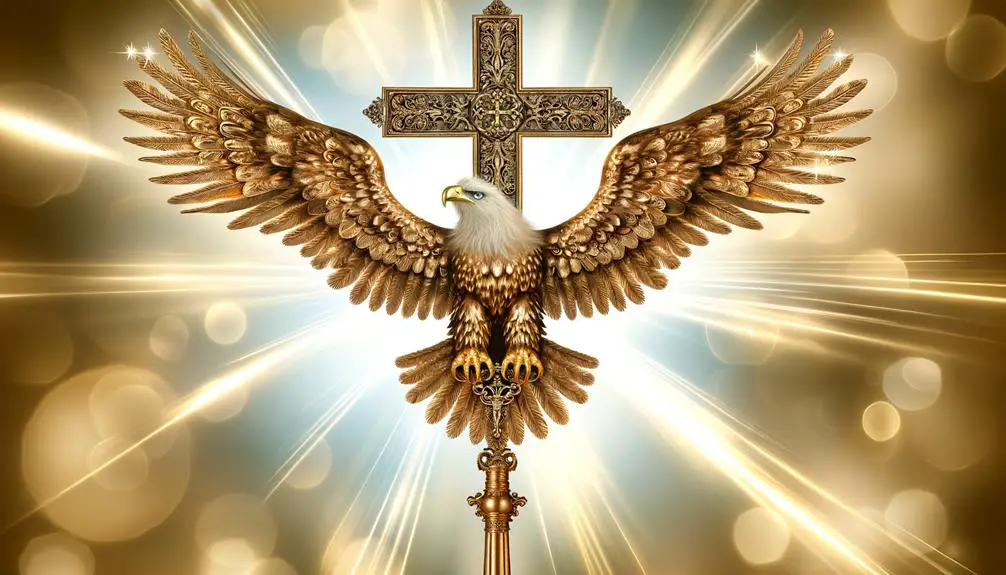
Key Takeaways
- The St John Eagle symbolizes divine revelation and spiritual vision rooted in early Christian iconography.
- It represents strength, courage, and spiritual ascension, reflecting St John's theological insights.
- Biblical references, particularly in Revelation and Isaiah, associate eagles with divine messages and renewed strength.
- Artistic depictions, from medieval manuscripts to Renaissance frescoes, emphasize the eagle as a symbol of elevated perspective and divine inspiration.
- Modern interpretations see the eagle as a metaphor for visionary leadership and the pursuit of knowledge.
Historical Background
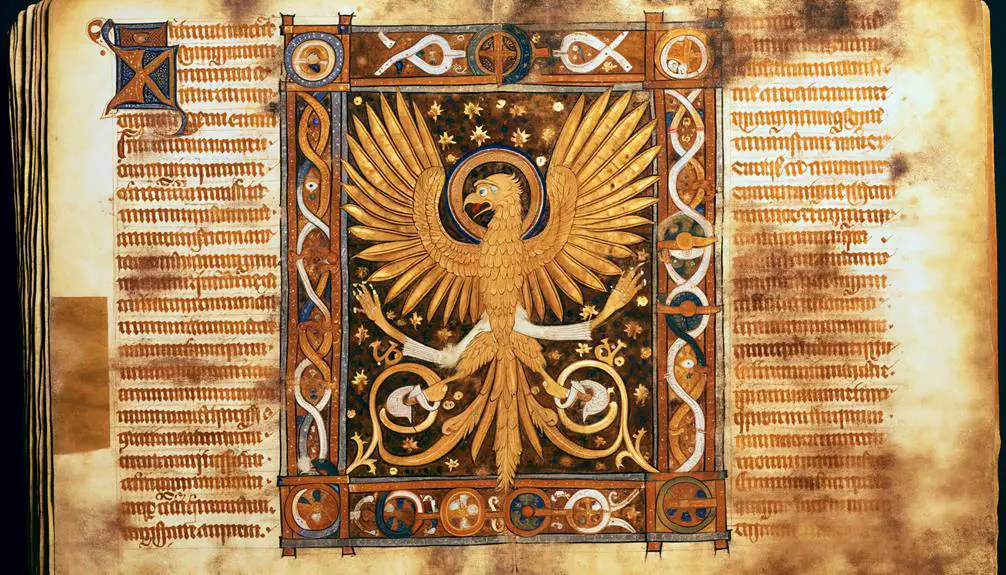
The historical background of the St John Eagle symbol is deeply rooted in early Christian iconography and medieval heraldry, reflecting a confluence of religious and cultural influences. Originating from the rich tapestry of Christian art, the eagle became associated with St John the Evangelist, symbolizing theological virtues such as vision and divine inspiration.
During the medieval period, this emblem was further absorbed into heraldic traditions, where it signified strength, courage, and spiritual ascension. The integration of such imagery into coats of arms and ecclesiastical art not only underscored the prominence of St John's theological contributions but also mirrored the broader societal reverence for biblical symbolism.
This intricate blend of iconographic and heraldic traditions illustrates the enduring legacy of the St John Eagle symbol.
Biblical References
Rooted in early Christian iconography, the association of the eagle with St John the Evangelist finds its basis in specific biblical references that highlight the theological and symbolic significance of this majestic bird.
Importantly, the Book of Revelation, attributed to St John, portrays visions of heavenly domains where eagles serve as divine messengers (Revelation 4:7). This imagery underscores the eagle's role in conveying divine revelation, mirroring John's theological emphasis on the transcendent nature of Christ.
Additionally, Isaiah 40:31's depiction of eagles soaring with renewed strength parallels John's lofty theological insights and spiritual depth. These biblical connections reinforce the eagle as an emblem of John's capacity for spiritual vision and profound understanding of divine mysteries.
Symbolism in Art

Artistic depictions of St John often incorporate the eagle as a potent symbol, reflecting his theological insights and the profound spiritual vision attributed to his writings. This avian imagery, prominent in medieval and Renaissance art, illustrates the evangelist's elevated perspective and divine inspiration, setting him apart from other biblical figures. The eagle's ability to soar to great heights metaphorically aligns with St John's capacity to reach celestial understanding.
| Artistic Period | Representation of Eagle | Symbolic Interpretation |
|---|---|---|
| Medieval | Manuscript Illuminations | Divine Vision |
| Renaissance | Paintings and Frescoes | Theological Insight |
| Baroque | Sculptures and Altarpieces | Spiritual Elevation |
These representations consistently underscore the spiritual and intellectual prowess attributed to St John, enhancing the viewer's comprehension of his unique role.
Theological Significance
Beyond its artistic portrayals, the eagle symbol in St John's iconography holds profound theological significance, representing his unmatched grasp of divine revelation and his role as a spiritual visionary.
The eagle's ability to soar to great heights mirrors St John's elevated theological insights, particularly evident in the prologue of his Gospel, where he explores the pre-existence and divinity of Christ. This high-flying bird thus symbolizes the lofty nature of St John's theological reflections, which transcend earthly concerns to explore the celestial domain.
Additionally, the eagle's sharp vision is emblematic of St John's prophetic clarity and his ability to perceive divine truths with exceptional acuity, reinforcing his standing as a principal theologian among the Evangelists.
Eagle in Early Christianity
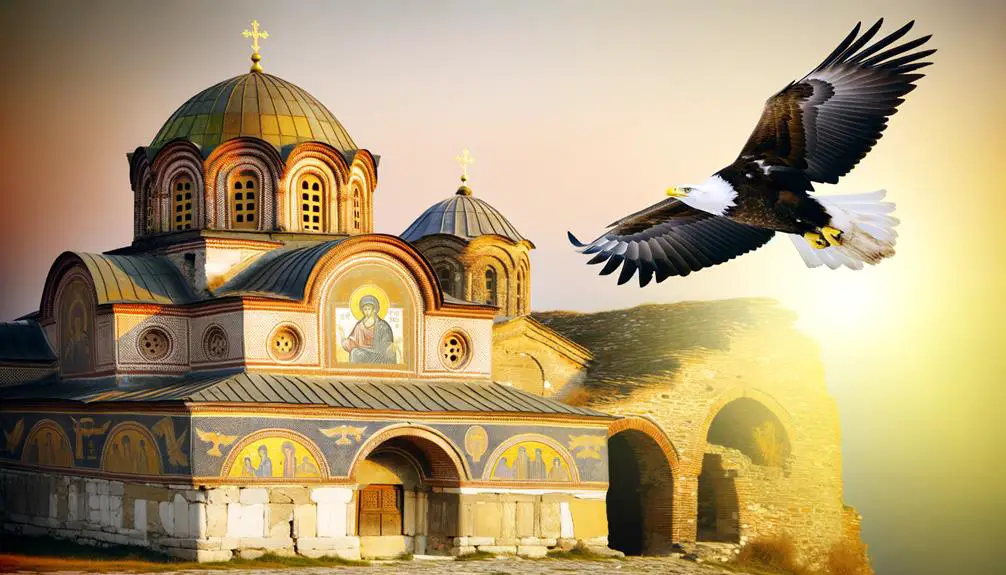
In early Christianity, the eagle emerged as a potent symbol embodying divine power and spiritual ascension. This association is rooted in the bird's ability to soar at great heights, metaphorically representing the soul's journey towards heavenly domains.
Such imagery was particularly significant in the context of St. John, whose theological writings emphasize the transcendence and elevated nature of divine wisdom.
Symbol of Divine Power
How did the eagle come to represent divine power in early Christianity, serving as a potent symbol of spiritual authority and transcendence?
The eagle, an emblem of strength and far-reaching vision, was adopted by early Christians to symbolize God's omnipotence and omniscience.
This majestic bird, soaring to great heights, paralleled the divine nature that transcends earthly limitations.
Scriptural references, such as those found in the Book of Revelation, where St. John's visions are depicted, strengthened this association.
The eagle's ability to fly close to the heavens made it an apt metaphor for divine power, emphasizing God's supreme authority over creation.
Within this framework, the eagle embodies a fusion of spiritual insight and heavenly supremacy, integral to early Christian iconography.
Representation of Ascension
The eagle's representation of ascension in early Christianity underscores the bird's symbolic association with spiritual elevation and the soul's journey towards divine communion. This majestic creature, often depicted soaring towards the heavens, epitomizes the Christian aspiration for a life aligned with divine principles and ultimate salvation.
The eagle's flight is emblematic of rising above earthly concerns, endeavoring for enlightenment, and seeking a closer relationship with God.
- Symbol of the soul's ascent to heaven: The eagle's ascent mirrors the soul's ascent to the divine domain.
- Representation in Christian art: Frequently portrayed in manuscripts and depictions.
- Biblical references: Linked to passages emphasizing renewal and strength (e.g., Isaiah 40:31).
- St John the Evangelist: Often associated with the eagle, reflecting his theological insights and divine inspiration.
This multifaceted symbol enriches the Christian narrative of spiritual transcendence.
Iconography Evolution
The evolution of the St John Eagle iconography encapsulates a dynamic trajectory from its historical origins in early Christian art to its nuanced interpretations in contemporary design.
Initially symbolizing divine inspiration and the lofty nature of St John's theological insights, the eagle has undergone various stylistic and thematic adaptations over the centuries.
These transformations reflect broader shifts in artistic conventions and theological emphases, highlighting the symbol's enduring relevance.
Historical Symbol Development
Tracing the iconographic evolution of the St John eagle symbol reveals a complex interplay of religious, cultural, and artistic influences over centuries. Initially, the eagle symbolized the divine inspiration of St John the Evangelist, as early Christian art sought to depict theological concepts visually.
Over time, the symbol's representation evolved, influenced by:
- Medieval Manuscripts: Illuminated scripts and codices often featured the eagle, merging religious significance with artistic embellishment.
- Renaissance Art: The period saw a resurgence in classical motifs, impacting the depiction of the eagle with a blend of naturalism and symbolism.
- Heraldic Traditions: The eagle became a powerful emblem in coats of arms, reinforcing its association with authority and vision.
- Liturgical Objects: Churches and cathedrals integrated the eagle into altars and lecterns, emphasizing its sacred connotations.
Contemporary Design Interpretations
In modern times, the St John eagle symbol has undergone a transformative reinterpretation, integrating contemporary design principles while retaining its rich historical and theological significance.
Designers now employ minimalist aesthetics, emphasizing clean lines and simplified forms to resonate with modern sensibilities. The eagle, traditionally depicted with intricate detail, is often abstracted, focusing on its iconic silhouette to evoke a sense of timelessness.
Additionally, the use of digital mediums allows for dynamic variations, ensuring adaptability across various platforms. This evolution reflects a broader trend in religious iconography, where traditional symbols are reimagined to maintain relevance in a rapidly changing cultural landscape.
Therefore, the St John eagle continues to symbolize spiritual elevation, now through a lens that bridges past and present.
Comparative Analysis
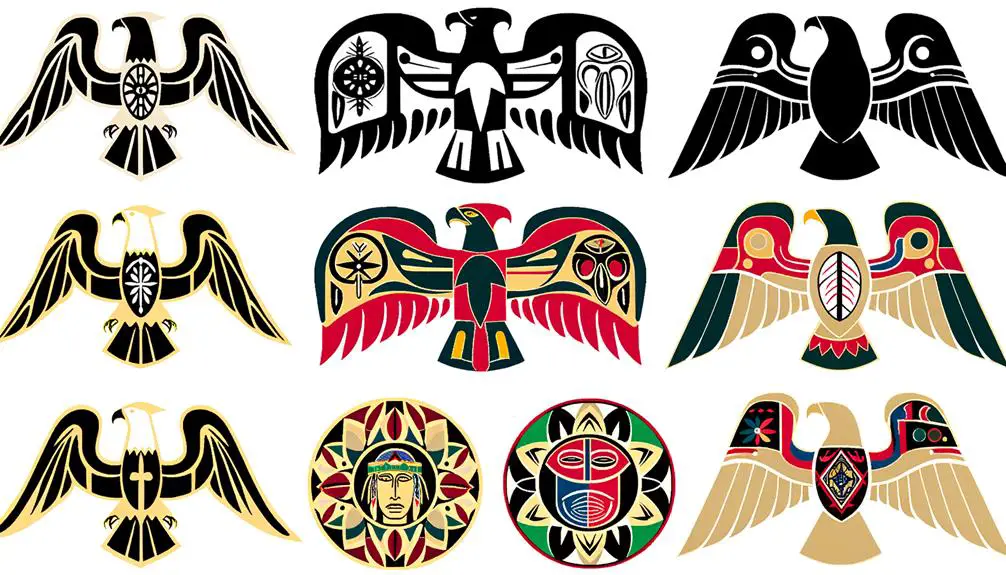
Examining the St John Eagle symbol alongside other heraldic and religious emblems reveals a complex interplay of cultural and historical influences. This comparative analysis illuminates how symbols can transcend their original contexts to convey broader meanings.
Key points of this analysis include:
- Religious Significance: The eagle is often linked to St John the Evangelist, symbolizing divine inspiration and ascension.
- Heraldic Usage: In heraldry, eagles represent courage, power, and keen vision, reflecting noble virtues.
- Cross-Cultural Parallels: Similar eagle symbols appear in Roman, Byzantine, and Native American traditions, indicating widespread reverence for this majestic bird.
- Evolution Over Time: The interpretation of the eagle emblem has evolved, adapting to changing socio-political and theological landscapes.
This multifaceted comparison enriches our understanding of the St John Eagle symbol's enduring legacy.
Artistic Representations
Artistic representations of the St John Eagle symbol reveal not only its aesthetic dimensions but also the diverse contexts in which it has been employed throughout history. From medieval illuminated manuscripts to contemporary ecclesiastical art, the symbol has been meticulously rendered to convey theological and doctrinal significance. The eagle, often depicted with outstretched wings and a penetrating gaze, serves as a powerful visual metaphor for divinity and enlightenment.
In stained glass windows, frescoes, and sculptural reliefs, artists have utilized various techniques to emphasize its majestic and transcendent qualities. These artistic interpretations provide not only a visual feast but also a deeper understanding of the symbol's role in religious and cultural narratives, enriching its historical and spiritual resonance.
Cultural Impact
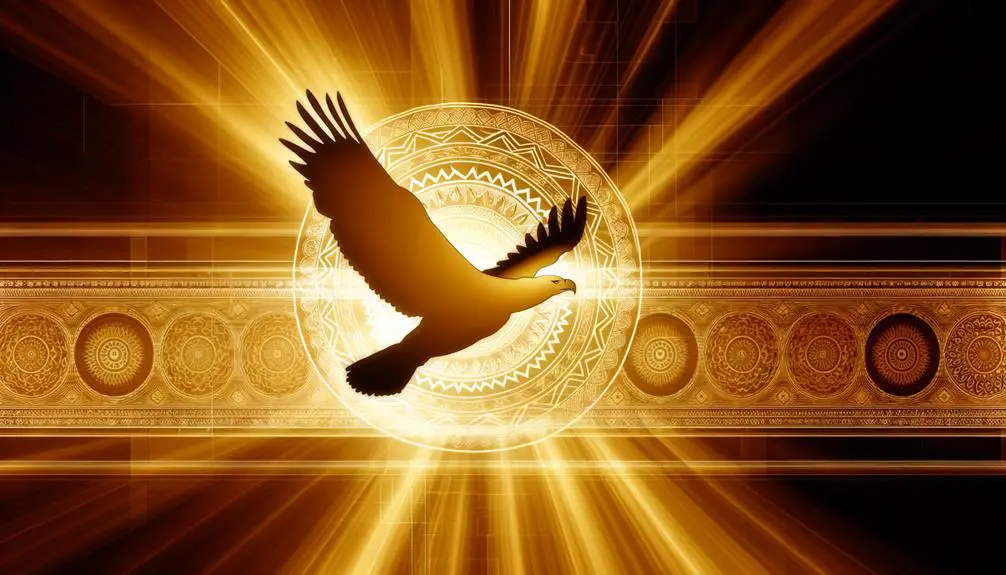
The St John Eagle symbol has profoundly shaped religious iconography and cultural narratives, serving as a central emblem of divine authority and spiritual insight across various epochs and societies. Its cultural impact is manifold, enriching the lexicon of symbols within Christian theology and beyond.
The eagle is often associated with:
- Vision and Prophecy: Representing St John's apocalyptic revelations.
- Exalted Status: Symbolizing the elevated nature of spiritual understanding.
- Transformation: Reflecting the soul's ascent to divine domains.
- Literary Influence: Inspiring countless works in literature and art.
Each of these facets underscores the eagle's role in embodying transcendent wisdom and eternal truths, thereby embedding itself deeply within the cultural and spiritual fabric of numerous civilizations.
Modern Interpretations
In contemporary contexts, the St John Eagle symbol continues to be reinterpreted, often serving as a metaphor for visionary leadership and the pursuit of higher knowledge within both religious and secular spheres.
Modern theologians and scholars posit that the eagle's capacity for soaring to great heights symbolizes spiritual transcendence and enlightenment.
In corporate and educational settings, the eagle represents strategic foresight and intellectual acumen, embodying the aspirational qualities of ambition and insight.
This dual applicability underscores the symbol's enduring relevance, bridging ancient iconography with present-day ideals.
Symbol in Literature
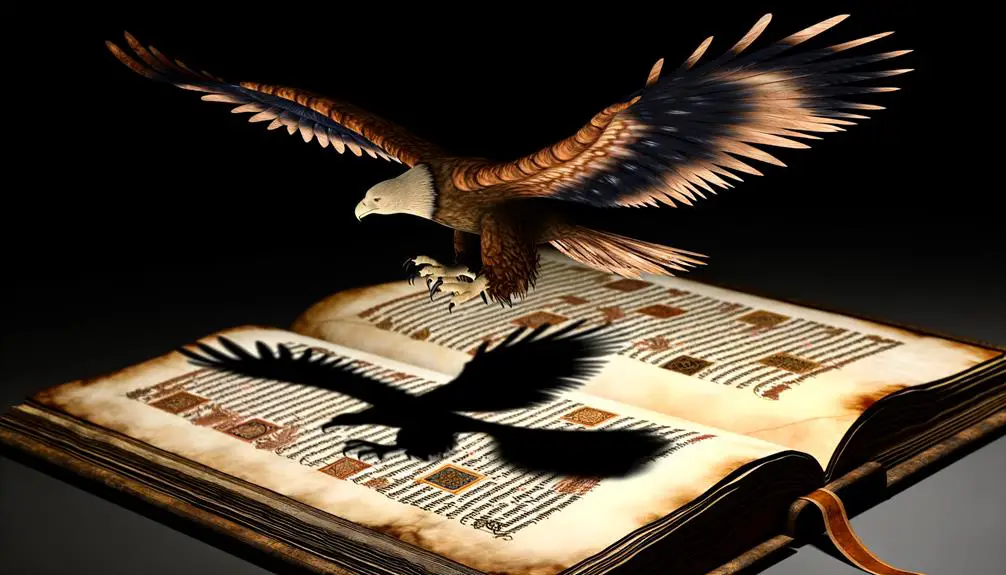
The symbol of the eagle associated with St. John has been extensively utilized in literature to convey profound allegorical meanings, particularly within the context of religious texts. This emblem often serves as a metaphorical device to represent divine inspiration and elevated spiritual vision, as seen in various theological writings.
Moreover, its adaptation in modern literature continues to underscore themes of transcendence and insight, bridging historical and contemporary narratives.
Allegorical Interpretations in Texts
Allegorical interpretations of the St John eagle symbol reveal profound insights into the thematic and narrative structures within literary texts. This potent symbol transcends mere representation, embodying a myriad of deeper meanings that enrich the reader's understanding.
The eagle's association with vision and ascension serves as a metaphor for higher knowledge and spiritual enlightenment. In analyzing its literary context, several key themes emerge:
- Transcendence and Aspiration: Reflects characters' quests for higher ideals.
- Prophetic Vision: Symbolizes foresight and insight within narratives.
- Authority and Power: Represents dominion and strength in thematic constructs.
- Transformation: Indicates personal growth and metamorphosis.
These allegorical layers invite readers to explore the intricate interplay between symbol and story, fostering a more profound engagement with the text.
Symbolism in Religious Works
Religious texts frequently employ the St John eagle symbol to convey themes of divine inspiration, spiritual elevation, and prophetic insight, enriching the interpretive layers of the narrative.
In Christian iconography, the eagle represents St John's soaring theological vision, particularly in the Gospel and the Book of Revelation. This symbol underscores his ability to perceive divine mysteries from a lofty, enlightened perspective.
The eagle, often associated with the heavens, signifies a bridge between the earthly and the divine, emphasizing transcendence and revelation. This imagery not only enhances the theological depth but also serves as a visual mnemonic for believers, underscoring the central tenets of faith, vision, and spiritual ascension within the religious text.
Representation in Modern Literature
Modern literature often adopts the St John eagle symbol to explore themes of enlightenment, insight, and the quest for higher understanding, reflecting its enduring significance beyond religious contexts. This emblematic figure, historically associated with the Apostle John's elevated vision, seamlessly integrates into contemporary narratives, enriching literary works with its multifaceted symbolism.
- Enlightenment and Knowledge: The eagle frequently represents a character's intellectual awakening or spiritual journey.
- Vision and Perspective: Authors use the eagle to signify keen perception or an elevated viewpoint, often in metaphoric terms.
- Transcendence: The symbol underscores themes of surpassing ordinary experiences, aiming for greater spiritual or intellectual heights.
- Resilience and Power: The majestic bird embodies strength and the capacity to overcome obstacles, aligning with protagonists' journeys.
In essence, the St John eagle symbol in modern literature serves as a versatile tool for thematic depth and character development.
Conclusion
Ironically, the eagle—often perceived as a symbol of earthly prowess and dominance—finds its profound significance in the spiritual and theological domains when associated with St. John.
This majestic bird, traditionally linked to lofty heights and keen vision, transcends its natural attributes to embody divine inspiration, theological insight, and spiritual ascension.
Through its varied representations in art, literature, and early Christian thought, the eagle encapsulates a paradox: a creature of the earth that ultimately symbolizes the heavens.





